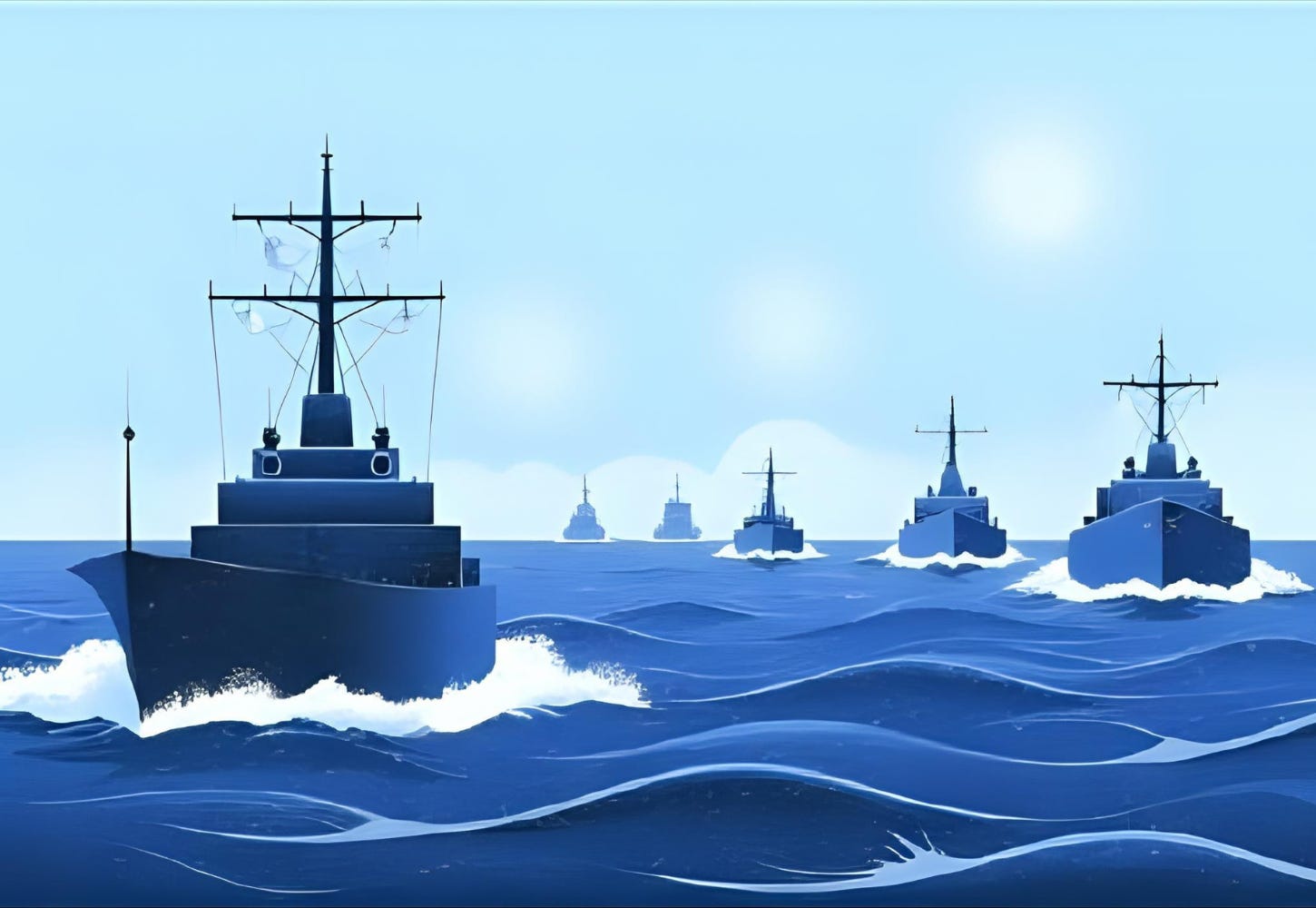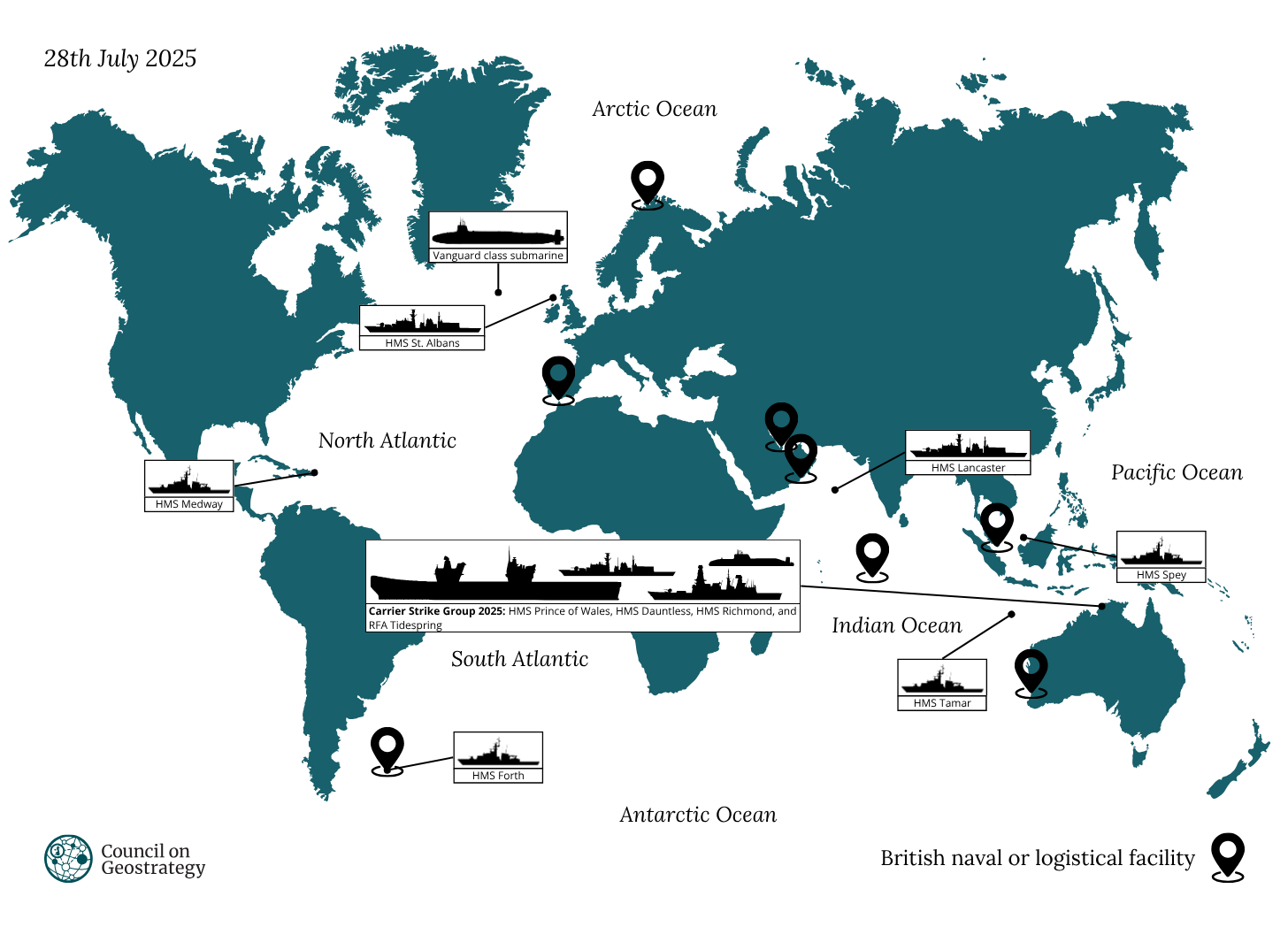Everyone gets their exercise(s) in
The Signal | No. 08.2025
Welcome to The Signal, your monthly maritime newsletter, written and edited by William Freer.
Thoughts from your correspondent
Exercise season is truly underway as we reach the end of July. For the Royal Navy, participation in TALISMAN SABRE 2025 was the main event of the month, but the Russian and French navies (further details on them later) also got their biggest exercises of the year in July.
TALISMAN SABRE is the largest bilateral military exercise between Australia and the United States (US), and often features multinational participation. This year, it put on a truly impressive performance with over 30,000 personnel from 19 different nations taking part; making it the largest TALISMAN SABRE to date. It featured a number of multi-domain exercises designed to test readiness, interoperability and combat capabilities.
The United Kingdom (UK) was a key presence in TALISMAN SABRE, with the Royal Navy’s Carrier Strike Group 2025 (CSG2025) – out on deployment in the Indo-Pacific – participating, as well as the presence of the Royal Air Force (RAF) and British Army. HMS Prince of Wales provided the centrepiece of the naval exercises alongside the US Navy’s Nimitz class carrier USS George Washington, leading a combined battlefleet of 27 vessels. Both carriers conducted cross-decking exercises, which saw US Marine Corps F-35B Lightning II Joint Combat Aircraft operate from HMS Prince of Wales while a British Merlin helicopter operated from the USS George Washington.
TALISMAN SABRE provided some truly impressive sites (do check out as many pictures as you can, they’re great!) and provided British and allied sailors with invaluable experience in conducting large-scale naval operations – an opportunity which does not happen frequently enough.
TALISMAN SABRE is a perfect encapsulation of what CSG2025 is all about. A large-scale military exercise to help hone the skills of the Royal Navy, build relationships with like-minded partners and deepen collaboration with those which the UK may one day find itself fighting alongside, whether in the Euro-Atlantic or the Indo-Pacific. That the Royal Navy’s participation in TALISMAN SABRE will be bookended by a suite of defence diplomacy engagements across the region is testament to the many benefits of CSG2025.
The only complaint one might have is that the readouts did not go into great detail. There are understandable reasons why those involved would not want everything they did – nor where successes or struggles were identified in the process – telegraphed to adversaries. But more detail about what was done, as the French provided for their recent POLARIS 25 exercise (which included a 20 page explainer beforehand as well as providing extensive information to the press) would be beneficial, and not just because this particular navy nerd wants to have data on sortie generation…
Tracking the deployments of the Royal Navy
Key movements:
HMS Prince of Wales arrived at Darwin, Australia, to much fanfare following her participation in TALISMAN SABRE, making her the first British aircraft carrier to visit an Australian port since 1997.
HMS St Albans is continuing her long TAPS (Towed-array sonar patrol) deployment in the North Atlantic to monitor Russian submarine activity.
HMS Spey joined the Japanese Maritime Self-Defence Force to help enforce sanctions against North Korea, a reflection of the wide-ranging utility of the humble Offshore Patrol Vessel.
HMS Lancaster’s commanding officer took the opportunity to celebrate the ship’s crew for their efforts on Operation KIPION. The ship is expected to depart the Middle East soon with no replacement; a reminder that one can never have enough frigates, and that the Royal Navy has been asked to do a lot with an overstretched frigate fleet. The new Type 31s and Type 26s cannot come soon enough!
Maritime news from allies and adversaries
People’s Republic of China (PRC): Images of a new Ekranoplan being spotted in the PRC has led to a swathe of unanswered questions. An Ekranoplan, also often called a ‘wing-in-ground’ effect aircraft, flies at incredibly low altitudes – just above the surface of the sea. It is not known why the PRC is experimenting with Ekranoplans nor what role the aircraft may fulfil, with special forces transport, maritime patrol or littoral logistics being just some of the potential answers.
Russia: In news which should surprise no one, the Russians are reportedly planning to abandon the refurbishment of their worn out (to put it mildly) aircraft carrier, the Admiral Kuznetsov. Moscow also conducted Exercise JULY STORM, which saw simultaneous activities from its Northern, Baltic and Pacific fleets. JULY STORM involved over 150 warships including auxiliaries, and is a reminder that the Russian naval threat remains serious.
United States: The US has signed a new logistics agreement with Japan and Australia designed to make the resupplying and rearming of US warships forwardly deployed in the Indo-Pacific far easier.
France: The Marine Nationale conducted an impressively large multi-domain exercise known as POLARIS 25, which involved more than 3,000 French and foreign troops, over 20 surface ships and more than 40 aircraft. The aim of the exercise was to be as realistic as possible and to involve stakeholders who do not usually take part; for the first time, the French merchant marine was directly involved. Other countries would do well to implement similar approaches to their own exercises.
Naval technology news
The Peregrine uncrewed rotary-wing aircraft could soon have Martlet Lightweight Multi-role Missiles (LMMs) integrated. Currently, the Peregrine is focused on surveillance roles, and has no armament. It will be able to carry two Martlet missiles. The Martlet is a cost-effective, short-range missile (with a range of roughly eight kilometres) capable of hitting moving targets such as drones both in the air and on the ground. While this would be a welcome boost to the capabilities offered by Peregrine, its overall value add is more limited considering that the Royal Navy’s Wildcat helicopters can carry 20 Martlets.
The Royal Navy has been undertaking ‘groundbreaking’ trials to demonstrate the launch and recovery of uncrewed underwater vehicles from its submarines. This trial, dubbed Project SCYLLA, took place in the Mediterranean, and was conducted through AUKUS Pillar II. The launch of uncrewed systems from torpedo tubes is nothing particularly noteworthy, but demonstrating the ability to recover via torpedo tubes is truly groundbreaking. These trials open a slew of new opportunities for the submarine fleets of the UK, US and Australia in their ability to ‘support underwater reconnaissance, underwater communications and seabed warfare missions’.
Saab and General Atomics are collaborating to develop an uncrewed airborne early warning solution. They have paired the MQ-9B drone with a suite of Saab sensors to offer distributed and persistent options for the airborne early warning mission. Such an approach could be one route which the Royal Navy looks into for improving the airborne early warning capabilities of the air wing for its aircraft carriers.
Who deserves a mention
Earlier this month, Thelma Redman, a Second World War veteran of the Women’s Royal Naval Service (more famously known as the ‘Wrens’), was presented with a letter from the First Sea Lord on her 101st birthday to honour her service.
This serves as an apt opportunity to highlight the role the Wrens played during the war. Although few served at sea, the contribution of the Wrens was significant, both directly in the jobs they did and indirectly in freeing up personnel for frontline service. At its height, 74,000 women were involved in over 200 different jobs. These included telegraphists, electricians and flying transport planes, with some also serving as cryptologists at Bletchley Park. 303 Wrens were killed in wartime service.
It wasn’t until 1990 that the first women went to sea with the Royal Navy, with the Wrens disbanded soon after in 1993 and amalgamated into the Royal Navy. The Wrens of the Second World War stepped up when their country needed them and helped to pave the way for future women dedicated to their naval service (some of whom this author is lucky enough to know).
Our present control of the sea is so absolute that it is sometimes taken for granted.
– Fleet Admiral Chester W. Nimitz, US Navy monthly newsletter, March 1948
A reading list on maritime matters
‘NATO Member States’ National Merchant Fleet and Seafarers’ by Nautilus International – a concerning overview of the current limitations facing North Atlantic Treaty Organisation (NATO) merchant fleets and the implications for the alliance’s logistics needs.
‘Giving Our “Paper Tiger” Real Teeth’ by Zachary Hughes – exploring the challenge of keeping ‘distributed’ forces supplied in a contested maritime environment and the importance of involving logisticians in defence planning processes (I’ve been very much in a contested logistics mindset recently, if it wasn’t already obvious).
‘Europe and Canada step up naval logistics’ by Johannes R. Fischbach and Louis Bearn for the International Institute of Strategic Studies – very much in keeping with the theme here. This short piece outlines the expansion and modernisation of European and Canadian naval auxiliaries, and includes a special (painful) shoutout to the Royal Fleet Auxiliary’s struggles.
William Freer is Research Fellow in National Security at the Council on Geostrategy.
To stay up to date with The Broadside, please subscribe or pledge your support!
What do you think about this article? Why not leave a comment below?










